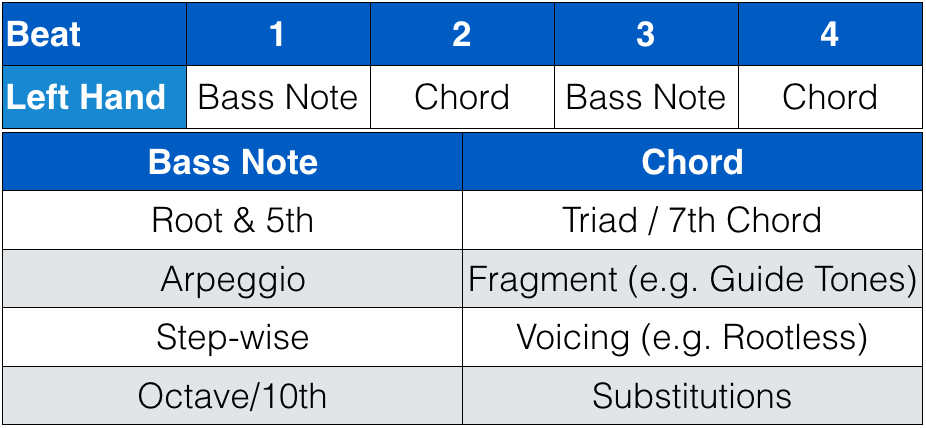Introduction
Stride piano is a conceptually simple but technically difficult left hand technique that was widely used by early Jazz pianists. It involves alternating between a bass note and a chord – with the bass note playing on beats 1 and 3, and the chord playing on beast 2 and 4. This creates a kind of ‘oom-pah’ sound where you play bass-chord-bass-chords and so on. And because you’re playing on every beat it creates quite a powerful and driving rhythm, and for that reason is a great technique for solo piano.
Stride Piano
Typically, the bass note is:
- A root or 5th;
- An arpeggio;
- A walking bass note that moves up by step;
- Played as a single note, octaves or 10ths.
Similarly, the chord is typically:
- A triad or 7th chord in any inversion;
- Some fragment of the chord, such as the guide tones;
- Some chord voicing (like rootless voicings);
- A chord substitution;
- Any other usual harmonic technique found in Jazz.

Varying It Up
This technique can get a bit boring to listen to after a while, because it’s so repetitive. So you can vary it up by doing things like:
- Reverse stride – so going chord-bass-chord-bass;
- Mixing it with a walking bassline;
- Playing two bass notes or chords in a row to vary the rhythm a bit;
- Anticipate bass notes or chord.
Simple Stride Exercise
What makes this technique challenging is the need to jump a fair distance to get from the bass note to the chord and back. So when you’re first learning this technique you want to minimise the distance you need to jump and minimise the complexity of the chords. A good way to do this is by using tenth triads and guide tones. Pick a relatively simple song that uses a lot of 2-5’s preferably where the chords change every half bar (like Satin Doll) and learn to play it as following:
- For the ii chord play a broken tenth triad (root – 3rd & 5th)
- For the V7 chord play the root notes and jump up to the guide tones (root – 3rd & 7th)

Make sure to practice this slowly and left hand separately. As I said, this is quite a difficult technique to master so be sure you’re patient. Ultimately, you want to be able to have play this automatically using just your muscle memory so that you can improvise with your right hand.
Have a Listen to
Have a listen to some of the below Stride Pianists for inspiration. Just be mindful that some of these guys are quite fast.
- Teddy Wilson
- Art Tatum
- James P. Johnson
- Willie “The Lion” Smith
- Fats Waller
- Luckey Roberts
- Eubie Blake
- Donald Lambert
- Cliff Jackson
- Dick Wellstood
- Mary Lou Williams
- Thelonious Monk